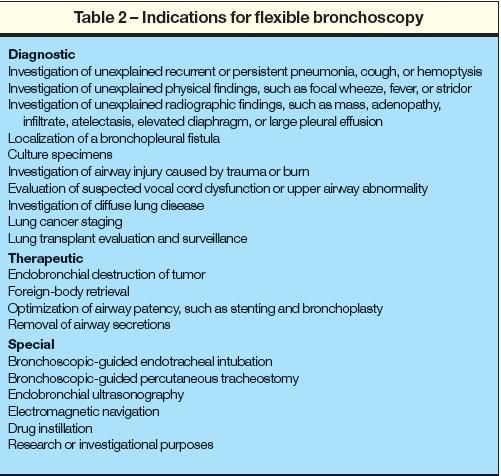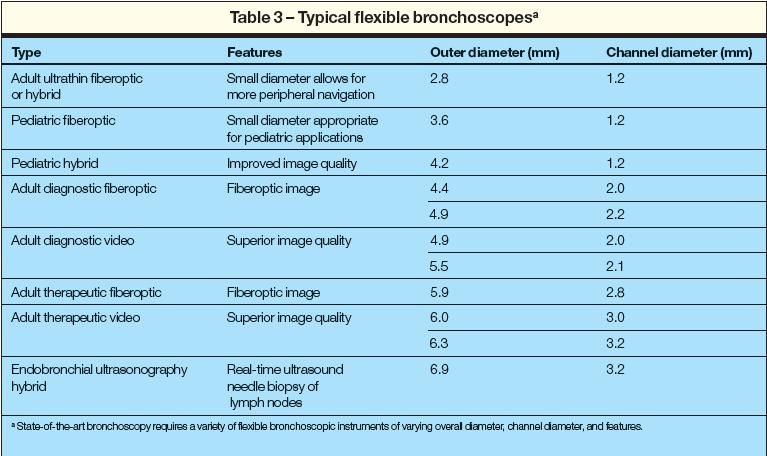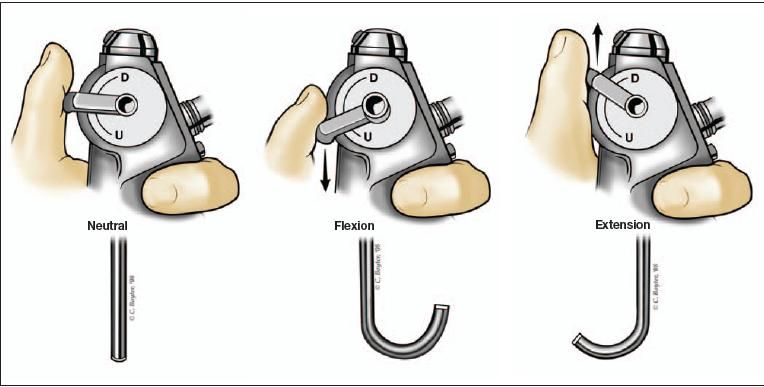- Clinical Technology
- Adult Immunization
- Hepatology
- Pediatric Immunization
- Screening
- Psychiatry
- Allergy
- Women's Health
- Cardiology
- Pediatrics
- Dermatology
- Endocrinology
- Pain Management
- Gastroenterology
- Infectious Disease
- Obesity Medicine
- Rheumatology
- Nephrology
- Neurology
- Pulmonology
The technique of adult flexible bronchoscopy: Part 1
ABSTRACT: Flexible bronchoscopy was clinically introduced byShigeto Ikeda in 1968 and is now used widely for diagnosticand therapeutic interventions. A combination of advancingtechnology and ingenuity has fostered the development of anexpanded array of devices and applications. The newer videobronchoscopes offer higher-resolution images than fiberopticbronchoscopes. The advantages of fiberoptic technology arelower cost and greater technical ease of adapting to smallerdiameterbronchoscopes. Hybrid bronchoscopes have an imaginglens and fiberoptic bundles that transmit the viewingimage to a charge couple device (CCD) chip in the body of theoperator end of the bronchoscope. The digital image is transmittedfrom the CCD chip to the external processor for viewingon a monitor, for digital storage, or for printing. (J Respir Dis.2008;29(11):423-428)
ABSTRACT: Flexible bronchoscopy was clinically introduced by Shigeto Ikeda in 1968 and is now used widely for diagnostic and therapeutic interventions. A combination of advancing technology and ingenuity has fostered the development of an expanded array of devices and applications. The newer video bronchoscopes offer higher-resolution images than fiberoptic bronchoscopes. The advantages of fiberoptic technology are lower cost and greater technical ease of adapting to smaller-diameter bronchoscopes. Hybrid bronchoscopes have an imaging lens and fiberoptic bundles that transmit the viewing image to a charge couple device (CCD) chip in the body of the operator end of the bronchoscope. The digital image is transmitted from the CCD chip to the external processor for viewing on a monitor, for digital storage, or for printing. (J Respir Dis. 2008;29(11):423-428)
Since its introduction by Shigeto Ikeda in 1968, flexible bronchoscopy has become a valuable diagnostic and therapeutic tool for pulmonologists- to a large degree, defining the subspecialty.1 Flexible bronchoscopy can be performed on spontaneously breathing patients in either the outpatient or inpatient setting and on more seriously ill patients who are on mechanical ventilation. This versatility has led to the development of a wide variety of techniques, tools, and procedures that provide unprecedented diagnostic and treatment options.
In this introduction to the series "The technique of adult flexible bronchoscopy," we categorize the various bronchoscopic procedures and discuss the indications, complications, basic equipment, and preprocedure preparations. While advanced procedures require additional skill and training, a thorough understanding and mastery of the fundamentals of bronchoscopy is a prerequisite. We present this introductory article to provide the foundation for the in-depth discussion of the basic technique of flexible bronchoscopy and the more advanced and specialized applications, which will appear in future issues of The Journal of Respiratory Diseases.
TYPES OF PROCEDURES
Flexible bronchoscopy can be divided into routine, advanced, and specialized procedures (Table 1). Routine bronchoscopy is performed by most pulmonologists and includes inspection and sampling. Inspection involves a survey of the upper and lower airway, with attention to the appearance and function of the vocal cords, the tracheal and bronchial anatomy, and the airway mucosa.

Advanced bronchoscopic procedures, such as transbronchial biopsy, are performed by some, but not all, pulmonologists because of the greater technical complexity and slightly higher risk. Specialized procedures, which include brachyradiation and bronchoplasty, are performed by relatively few pulmonologists and may require advanced training.
Flexible bronchoscopy is also used in a few special circumstances, such as the evaluation of vocal cord dysfunction. Investigational bronchoscopic procedures should generally be performed in a clinical trial setting.
INDICATIONS
Flexible bronchoscopy can be performed for diagnostic purposes, such as the investigation of hemoptysis or a radiographic abnormality, or for therapeutic purposes, such as laser resection of a tumor or airway clearance (Table 2). As noted above, flexible bronchoscopy may also be

used under special circumstances to facilitate other procedures, such as endotracheal intubation, or for investigational or research purposes.
COMPLICATIONS
It is not uncommon for patients to experience minor discomfort, nausea, coughing, gagging, minimal bleeding (bleeding not requiring continued suctioning), mild and transient decrease in oxygen saturation, or fever. These occurrences are not generally considered complications. Minor complications are uncommon and include moderate bleeding (persistent bleeding requiring continued suctioning of blood or wedging of the bronchoscope), persistent hypoxemia, self-limited laryngospasm, vomiting, bronchospasm, epistaxis, and vasovagal syncope.
Major complications directly attributable to flexible bronchoscopy are less common and include the following: pneumonia or other serious infection, aspiration pneumonitis, arrhythmias, allergic reactions, pneumomediastinum, septic pericarditis, mediastinal hemorrhage, pulmonary edema, airway obstruction, pneumothorax, severe bleeding (bleeding requiring interventions such as a tamponade balloon, admission to a higher level of care, or blood transfusion), pulmonary hemorrhage (more than 50 mL), seizure, respiratory failure, and cardiac arrest. In a large retrospective review of 4273 flexible bronchoscopies performed at a single university teaching hospital, minor and major complications occurred in 0.8% and 0.5% of bronchoscopies, respectively.2
The risk to an individual patient is difficult to predict because the incidence and type of complication are highly dependent on the skill and experience of the bronchoscopist, the patient's underlying medical condition, and the specific procedure being performed. Certain complications, such as pneumothorax, major bleeding, pneumomediastinum, septic pericarditis, and mediastinal hemorrhage, occur almost exclusively with more invasive procedures (such as endobronchial biopsy, transbronchial biopsy, transbronchial needle aspiration, airway stenting, and tumor destruction).
Complications such as heart attack, stroke, or death are very rare and usually occur in settings involving high-risk patients or high-risk procedures. Composite data from 3 large retrospective surveys of bronchoscopists, with a total of more than 112,000bronchoscopies performed in the United States, demonstrate a mortality rate of about 0.025%.3-5 A large prospective study of more than 4000 bronchoscopies at a single institution revealed no deaths,2 while smaller prospective studies with a combined total of 1113 bronchoscopies suggest a mortality rate of 0.089%.6-8
BRONCHOSCOPY EQUIPMENT
Flexible bronchoscopes are now generally categorized as video, fiberoptic, or hybrid. The newer video (also referred to as "chip") bronchoscopes differ from older fiberoptic bronchoscopes in their image acquisition and transmission. The video bronchoscopic image is captured via a charge couple device (CCD) chip at the distal tip of the bronchoscope that digitally captures the viewing image. The image is transferred electronically through the bronchoscope to the processor.
With fiberoptic bronchoscopes, the viewing field is imaged by a lens of fixed focal length located at the tip of the bronchoscope (Figure 1). The image is transmitted optically to the proximal head of the instrument via fiberoptic bundles, where it can be directly visualized through a lens at the head of the bronchoscope. Alternatively, a camera can be attached to the head of the fiberoptic bronchoscope and the image sent to the processor.

Figure 1 – The video bronchoscopic image is captured via a charge couple device (CCD) chip at the distal tip of the bronchoscope that digitally captures the viewing image. The image is transferred electronically through the bronchoscope to the processor. With fiberoptic bronchoscopes, the viewing field is imaged by a lens of fixed focal length located at the tip of the bronchoscope. The image is transmitted optically to the proximal head of the instrument via fiberoptic bundles, where it can be directly visualized through a lens at the head of the bronchoscope. The light is transmitted through the bronchoscope via fiberoptic light bundles that direct light out the distal end of the bronchoscope, illuminating the viewing field.
With both fiberoptic and video bronchoscopes, the processor allows for viewing the image on a video monitor, still and/or video image storage, electronic transmission, or printing. Viewing on a high resolution monitor magnifies the image, providing greater detail, operator control, and quality.
Fiberoptic bronchoscopes cannot inherently offer resolution as high as video bronchoscopes. The advantages of fiberoptic technology are lower cost and greater technical ease of adapting it to smaller-diameter bronchoscopes. Video bronchoscopes offer higher-resolution images than fiberoptic bronchoscopes because they do not require fiberoptic bundles to transmit an image to the camera; however, fiberoptic bundles are still required to transmit light to illuminate the airway. The disadvantages of video bronchoscopes are that the CCD chip is larger than the fiberoptic lens, resulting in a larger outer diameter to channel diameter, and that they are more expensive.
Hybrid bronchoscopes have an imaging lens and fiberoptic bundles that transmit the viewing image to a CCD chip located in the body of the operator end of the bronchoscope. The digital image is transmitted from the CCD chip to the external processor for viewing on a monitor, for digital storage, or for printing. For certain applications, hybrid bronchoscopes offer a necessary compromise between cost, insertion diameter, and image quality.
Bronchoscopic imaging requires a bright but cool light source to illuminate the field. Portable models have a battery-powered light source that is attached directly to the bronchoscope. All other models make use of an external light source that feeds into the bronchoscope. The light is transmitted through the bronchoscope via fiberoptic light bundles that direct light out the distal end of the bronchoscope, illuminating the viewing field.
State-of-the-art bronchoscopy requires a variety of flexible bronchoscopic instruments of varying outer diameter, channel diameter, and features (Table 3). The smallestdiameter (approximately 2.2 mm) bronchoscopes commercially available in the United States are referred to as ultrathin bronchoscopes. Their small diameter allows for navigation into the distal airways, but their utility is limited by the lack of a working channel and fiberoptic imaging.

Larger-diameter (approximately 2.8 mm) pediatric bronchoscopes can be used in adults to navigate to slightly larger but relatively distal airways to visualize peripheral lung lesions and obtain biopsy specimens. The limitations of these instruments include fiberoptic imaging and a small working channel (approximately 1.2 mm in diameter) with reduced suctioning capabilities and instrument size.
Larger bronchoscopes can integrate higher-quality video imaging with large working channels up to 3.2 mm in diameter, which allow for more effective clearance of thick secretions or blood from the airways and for passage of larger instruments. The major disadvantages of larger bronchoscopes are that they are less maneuverable and their larger size (up to 6.3 mm) may preclude passage through the naris, through an endotracheal tube, or into more distal airways.
Typical flexible bronchoscopes have a working length of approximately 600 mm and a total overall length of about 900 mm. Depending on the model, the distal tip can be flexed forward 120 to 210 degrees by pushing a lever located on the head of the bronchoscope downward. It can be extended backward 80 to 160 degrees by pushing the lever upward. Integrating clockwise and counterclockwise rotation of the body of the bronchoscope with flexion and extension of the tip, the operator can achieve a 360- degree view of the airway lumen (Figure 2).

Figure 2 – Flexion and extension of the distal tip of the bronchoscope are illustrated here. With the lever in mid-position, the distal tip of the bronchoscope is in the neutral position. When the lever is pushed down, the tip of the bronchoscope is flexed forward up to 130 degrees (flexion). When the lever is pushed up, the tip of the bronchoscope is extended backward up to 110 degrees (extension).
Although certain specific features are required for some advanced specialty bronchoscopic procedures, flexible bronchoscopes share a similar design and function. Special options, such as endobronchial ultrasonography and electromagnetic navigation, require additional technology, bronchoscopes, or other equipment.
PREBRONCHOSCOPY
The screening assessment
As for any invasive procedure, an appropriately thorough preprocedure history, physical examination, assessment, and care plan should be performed and documented. Particular attention should be paid to the patient's respiratory and cardiac status, drug allergies, previous bronchoscopic procedures, and history of anesthetic or bleeding complications. Absolute contraindications are few and are patient- and situation-dependent. Routine laboratory examination to screen for potential bleeding complications is unnecessary in the absence of suspected or known pulmonary arterial hypertension, thrombocytopenia coagulation disorder, liver dysfunction, uremia, and AIDS.9
Elective bronchoscopy should be avoided during acute exacerbations of asthma, but bronchoscopy may be indicated in this setting to facilitate endotracheal intubation or after the patient is placed on mechanical ventilation. In general, great caution is warranted in performing bronchoscopy on nonintubated patients who require high-flow oxygen with a face mask. In these patients, elective endotracheal intubation before proceeding to diagnostic or therapeutic bronchoscopy may sometimes be warranted.
Elective bronchoscopy should be avoided within 6 weeks of an acute myocardial infarction.10,11 Conversely, urgent or emergent bronchoscopy may benefit critically ill patients in the coronary care unit.Thus, the risks and benefits of the procedure must be weighed on a case-by-case basis.12
patient instruction patient
Patients should be given information and instruction, both verbally and in writing, regarding the bronchoscopic procedure and the required patient preparation.10 We provide patients with a 2-page pamphlet describing the procedure and a customized instruction sheet with the date, time, and location of the bronchoscopy; instructions on fasting and medications (including anticoagulants, aspirin and other NSAIDs, clopidogrel, insulin, oral hypoglycemics, and the patient's routine medications); requirements for transportation; and telephone contact information.
To reduce bleeding risk, patients should stop taking clopidogrel for 5 to 7 days13 and anticoagulants for 4 to 6 days before the procedure. Aspirin and other NSAIDs do not appear to increase the risk of bleeding complications.14 Nevertheless, whenever biopsies are being considered and there is a concern for an increased risk of bleeding, we have patients stop taking aspirin 3 days and other NSAIDs 1 day before bronchoscopy.
The risks and benefits of stopping these medications must be weighed on an individual basis and depend on the indications for the medication as well as the nature of the planned procedure. Published guidelines on the evaluation of bleeding risks and management of anticoagulants in the perioperative setting are available.15-17
When undergoing elective bronchoscopy with sedation, patients should have an empty stomach. We require patients to be without solid food for at least 8 hours, formula-type feeds for at least 6 hours, and clear liquids for at least 2 hours before the procedure. Patients are usually allowed to take their routine medications with a small sip of water before bronchoscopy.
Consent
Consent should be obtained from patients or their surrogate after the pertinent risks, benefits, nature of the procedure; potential complications; and alternatives have been clearly explained. Complete details of the proper components and procedure for obtaining informed consent may be found in a 2007 review by Terry.18
References:
REFERENCES
1.
Ikeda S, Yanai N, Ishikawa S. Flexible bronchofiberscope.
Keio J Med.
1968;17:1-16.
2.
Pue CA, Pacht ER. Complications of fiberoptic bronchoscopy at a university hospital.
Chest.
1995;107:430-432.
3.
Credle WF Jr, Smiddy JF, Elliott RC. Complications of fiberoptic bronchoscopy.
Am Rev Respir Dis.
1974;109:67-72.
4.
Suratt PM, Smiddy JF, Gruber B. Deaths and complications associated with fiberoptic bronchoscopy.
Chest.
1976;69:747-751.
5.
Simpson FG, Arnold AG, Purvis A, et al. Postal survey of bronchoscopic practice by physicians in the United Kingdom.
Thorax.
1986;41:311-317.
6.
Dreisin RB, Albert RK, Talley PA, et al. Flexible fiberoptic bronchoscopy in the teaching hospital. Yield and complications.
Chest.
1978;74:144-149.
7.
Pereira W Jr, Kovnat DM, Snider GL. A prospective cooperative study of complications following flexible fiberoptic bronchoscopy.
Chest.
1978;73:813-816.
8.
Lukomsky GI, Ovchinnikov AA, Bilal A. Complications of bronchoscopy: comparison of rigid bronchoscopy under general anesthesia and flexible fiberoptic bronchoscopy under topical anesthesia.
Chest.
1981;79:316-321.
9.
Kozak EA, Brath LK. Do "screening" coagulation tests predict bleeding in patients undergoing fiberoptic bronchoscopy with biopsy?
Chest.
1994;106:703-705.
10.
British Thoracic Society Bronchoscopy Guidelines Committee. British Thoracic Society guidelines on diagnostic flexible bronchoscopy.
Thorax.
2001;56(suppl 1):i1-21.
11.
Eagle KA, Brundage BH, Chaitman BR, et al. Guidelines for perioperative cardiovascular evaluation for noncardiac surgery. Report of the American College of Cardiology/American Heart Association Task Force on Practice Guidelines. Committee on Perioperative Cardiovascular Evaluation for Noncardiac Surgery.
Circulation.
1996;93:1278-1317.
12.
Fiberoptic bronchoscopy in coronary care unit patients: indications, safety, and clinical implications.
Chest.
1998;114:1660-1667.
13.
Ernst A, Eberhardt R, Wahidi M, et al. Effect of routine clopidogrel use on bleeding complications after transbronchial biopsy in humans.
Chest.
2006;129:734-737.
14.
Herth FJ, Becker HD, Ernst A. Aspirin does not increase bleeding complications after transbronchial biopsy.
Chest.
2002;122:1461-1464.
15.
Baglin TP, Keeling DM, Watson HG; Committee for Standards in Haematology. Guidelines on oral anticoagulation (warfarin): third edition-2005 update.
Br J Haematol.
2006;132:277-285.
16.
Chee YL, Crawford JC, Watson HG, Greaves M. Guidelines on the assessment of bleeding risk prior to surgery or invasive procedures. British Committee for Standards in Haematology.
Br J Haematol.
2008;40:496-504.
17.
Ansell J, Hirsh J, Poller L, et al. The pharmacology and management of the vitamin K antagonists: the Seventh ACCP Conference on Antithrombotic and Thrombolytic Therapy [published correction appears in
Chest.
2005;127:415-416 (dosage error in text)].
Chest.
2004;126(3 suppl):204S-233S.
18.
Terry PB. Informed consent in clinical medicine.
Chest.
2007;131:563-568.
